Book contents
- Frontmatter
- Contents
- List of Tables, Figures, and Maps
- Preface
- List of Abbreviations
- 1 The Mortality Revolution and the Tropical World: Relocation Costs in the Early Nineteenth Century
- 2 Sanitation and Tropical Hygiene at Midcentury
- 3 Killing Diseases of the Tropical World
- 4 Relocation Costs in the Late Nineteenth Century
- 5 The Revolution in Hygiene and Tropical Medicine
- 6 The Pursuit of Disease, 1870–1914
- Conclusion
- Appendix Statistical Tables
- Bibliography
- Index
6 - The Pursuit of Disease, 1870–1914
Published online by Cambridge University Press: 29 March 2010
- Frontmatter
- Contents
- List of Tables, Figures, and Maps
- Preface
- List of Abbreviations
- 1 The Mortality Revolution and the Tropical World: Relocation Costs in the Early Nineteenth Century
- 2 Sanitation and Tropical Hygiene at Midcentury
- 3 Killing Diseases of the Tropical World
- 4 Relocation Costs in the Late Nineteenth Century
- 5 The Revolution in Hygiene and Tropical Medicine
- 6 The Pursuit of Disease, 1870–1914
- Conclusion
- Appendix Statistical Tables
- Bibliography
- Index
Summary
Even though specific therapy made slow progress until after 1914, in the period between the 1890s and the beginning of the war, the combination of general hygienic measures and better ways to fight particular diseases brought the steepest percentage decline of the whole century in the death rate of soldiers at home or abroad. The best of medical knowledge was not automatically translated into practice, but the information network available to military doctors steadily narrowed the time gap between discovery and implementation of practical preventive measures.
Yellow Fever
Yellow fever was a special case – unknown in Asia, only rarely seen in Europe. Like other epidemic disease, it varied through time. From the 1870s to the 1890s, however, it accounted for a quarter of all deaths from disease among British troops in the West Indies. Only typhoid fever was a serious rival, and typhoid caused more deaths than yellow fever only in the sample period, 1886–94.
Down to 1900, medical men could only suspect the cause, and they had no cure. Yet the trend in mortality for European troops was slightly downward, both in deaths per thousand and the proportion of total deaths (Table 6.1). A peak for this half-century occurred in the late 1870s and early 1880s, but still higher peaks must have occurred before the 1860s, although British army records failed to distinguish yellow fever from malaria at that time. The Jamaican death rate from “fevers,” for example, was more than 100 per thousand for 1817–36 (Table 1.6) – a figure that certainly hid some very high yellow fever death rates in particular years.
- Type
- Chapter
- Information
- Death by MigrationEurope's Encounter with the Tropical World in the Nineteenth Century, pp. 130 - 158Publisher: Cambridge University PressPrint publication year: 1989



